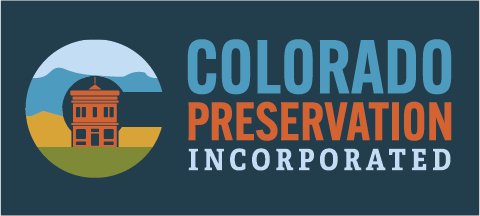ANNOUNCED 12:30 p.m. February 11, 2021
Contact: [email protected] 720.837.3845 or
Kim Grant at [email protected]
Denver (February 11, 2021)—Colorado’s Most Endangered Places List was announced today by CBS4 Meteorologist Dave Aguilera at Colorado Preservation, Inc.’s Saving Places 2021 virtual Preservation in Action conference. Three new sites were added to the list as noted below.
Since 1998, Colorado Preservation, Inc. has been working with communities throughout the state to save threatened or endangered historic buildings, landscapes, and archaeological sites through its Endangered Places Program. Three new diverse sites were added to the 2021 list today, while two previously listed sites were recognized as SAVED.
2021 marks the 24th anniversary of Colorado Preservation, Inc.’s Most Endangered Places list. The program provides advocacy, awareness, and technical assistance to significant historic sites throughout Colorado that are in danger of being lost. Colorado Preservation, Inc. devotes staff time and resources to build partnerships, raise funds, and rally concerned citizens so that listed sites can be saved. In 24 years, the Colorado’s Most Endangered Places program has highlighted 130 historic sites throughout the state; 52 sites have been SAVED and only seven have been lost, with 47 actively in progress and 24 still under alert status. The program has a wide reach throughout rural and urban areas of the state and has helped local communities save a wide array of historic resources, from agricultural and archaeological resources to commercial districts, downtown properties, cultural landscapes, ditches, kilns, barns, flumes, mining structures, schools, churches, government buildings, and railroad resources.
Three historic sites were selected for the 2021 list of Colorado’s Most Endangered Places:
- Historic Bridges of Colorado (Statewide)
As a state with many distinguishing geophysical characteristics, including mountains and plains and rivers and streams, Colorado has by necessity many historic bridges that reflect its diverse regions and cultural heritage. But until recently, there has never been a strong bridge preservation ethic in the state. CPI, in conjunction with the Colorado Department of Transportation (CDOT), has embarked on a partnership to identify forty-six (46) on-system bridges representing different types, eras, and locations, for preservation in place of at least 20 priority structures. The bridges under consideration range in age from 1888 to 1973 and span the full breadth of Colorado’s bridge development, which evolved from early timber structures and steel bridges to the use of more functional and standardized designs using pre-stressed concrete in the post-World War II era. Listing these bridges will assist CPI and CDOT in developing partnerships with local communities and other organizations for funding and support for bridge preservation efforts.
- Lafayette Head Home & Ute Indian Agency (Conejos County)
For a relatively brief, but formative period in Colorado, the Lafayette Head Home & Ute Indian Agency in Conejos was the center of the universe for a diverse convergence of cultures and forces that changed the state’s history. The Lafayette Head Home & Ute Indian Agency was built by early settler, businessman, and public official Lafayette Head in 1855, and played an important, but little-known role in the settlement of Colorado in the period before and after statehood. Head used his home and compound as the agency headquarters while working with the Ute and Jicarilla Apache tribes for nine years during a time of uneasy co-existence, conflict, settlement, and displacement. Head and was instrumental in treaty negotiations with the Ute tribes in Washington, D.C. that led to the relinquishment of San Luis Valley lands to the United States and the establishment of the Southern Ute and Ute Mountain Ute reservations in far southwest Colorado. The Head House itself is representative of Indo-Hispano, Native American, Territorial, and early Colorado architecture. Head was elected to the Colorado State Legislature and was one of 39 delegates who drafted the 1875 State Constitution. He was also elected the first Colorado Lieutenant Governor under Governor John Routt. CPI will work with local, state and educational and tribal partners to preserve and interpret the Head Home and site so future generations can be understand the role the region played in the state’ history.
- Winter Park Balcony House (Grand County)
Winter Park’s original base area ski lodge, known as the Balcony House, vividly represents the early history and pioneering evolution of the City of Denver’s first Mountain Park, while also fostering groundbreaking developments in the Colorado ski industry as a whole. Since 1955, the Balcony House has played an essential role in skiing, snowboarding and summer activities, and in enhancing the overall experience of visitors. The two-story Balcony House, with its panoramic views from cascading balconies, is a prime example of Mid-century Modern architecture and may be the only remaining Mid-century Modern public ski lodge in Colorado. The Balcony House is threatened by under-appreciation of its significance and uniqueness and a 2009 Master Plan that calls for its demolition and replacement with 5-6 stories of condominiums above one level of resort operations. Advocates for preservation think a better way can be found to accommodate future growth, operations, and programming without sacrificing the Balcony House. Listing on Colorado’s Most Endangered Places is intended to be a catalyst for further discussion with the Winter Park Recreation Area (WPRA) and Alterra Mountain Company, developers of the ski resort, about how to work together to preserve Winter Park Ski Area’s most authentic building.
Two sites previously listed on Colorado’s Most Endangered Places were recognized as SAVES:
- Gold Medal Orchard (Montezuma County)
- Goodnight Barn (Pueblo County)
This project is paid for in part by a History Colorado State Historical Fund grant. Colorado’s Most Endangered Places are located throughout the state. The general public is invited to visit, learn, and be inspired!
